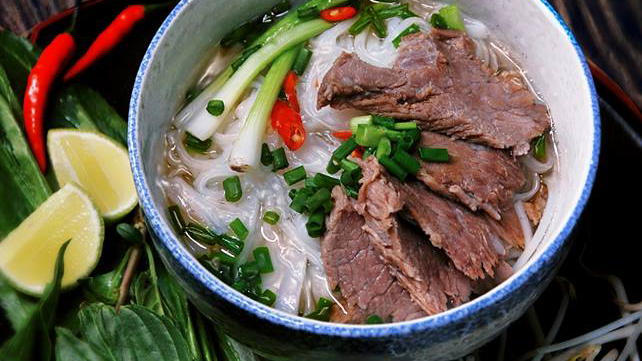In spices used for example, a balance is sought between sour, bitter, sweet, spicy, and salty. In presentation, cooks aim to have the colors green, red, yellow, white, and black in their dishes. Vietnamese food is considered one of the healthiest cuisines in the world and this is due in part to a balance of nutrients like carbohydrates, fat, protein, minerals, and water.
Nationwide
Bánh Canh
This was my favorite noodle soup dish in Vietnam. Bánh canh means “soup cake” and refers to a thick Vietnamese noodle that can be made either from tapioca flour or a mixture of rice and tapioca flour. The “cake” in its name refers to the thick sheet of uncooked dough from which the noodles are cut. Depending on its ingredients, there are many types of bánh canh. Bánh canh cua, for example, is made with sumptuous chunks of crab (cua) while bánh canh chả cá, a version popular in Central Vietnam, is made with pork and fish cake.
Bánh Cuốn
Bánh cuốn are rice rolls made from a thin sheet of steamed fermented rice batter filled with seasoned ground pork and wood ear mushrooms. Topped with herbs and fried shallots and served with a bowl of nước chấm (fish sauce), they’re typically served with a side of giò lụa (Vietnamese pork sausage), sliced cucumber, and bean sprouts. Bánh Cuốn is typically made with pork (bánh cuốn nhân thịt) but this restaurant made a few other varieties as well, including one filled with shrimp called bánh cuốn nhân tôm. We tried one of each and both were delicious. They were soft, slippery, and a little gummy with bits of crunchy fried shallots and fresh herbs.
Bánh Mì
Like pho, bánh mì is one of Vietnam’s most iconic and recognizable dishes. Even if you aren’t that familiar with Vietnamese food, chances are you’ve at least heard of bánh mì. It’s considered a national dish and can be found pretty much anywhere in Vietnam.
Strictly speaking, “bánh mì” is the Vietnamese word for the baguette which was introduced by the French during the colonial period. But when most people say “bánh mì”, they’re referring specifically to the baguette sandwich made with different types of meat, vegetables, and condiments. Pork is frequently used and its incorporated into the sandwich in many forms like pâté, grilled patties, Vietnamese sausage, cold cuts, terrine, and floss. Commonly used vegetables include cucumber slices, coriander, pickled carrots, and shredded radish. But like any sandwich, you can basically put whatever you want in a bánh mì so there are many varieties made with other ingredients as well like duck, egg, grilled chicken, fish cake, etc.
Chè
Chè is the blanket term used to describe a family of Vietnamese dessert soups, sweet beverages, or pudding. Served hot or cold, there are endless varieties of chè made with all kinds of ingredients like coconut milk, beans, tapioca, jelly, fruit, seeds, tubers, grains, cereals, and glutinous rice. Some varieties even include dumplings. Basically, if it’s sweet and comes in soup or pudding form, then it can probably be classified as chè.
Vietnam can get brutally hot so slurping down ice-cold bowls of chè is a great way to cool down.
Nem Cuốn (north) / Gỏi Cuốn (south)
Known as nem cuốn in the north and gỏi cuốn in the south, these fresh spring rolls are a Vietnamese national dish. They’re traditionally made with shrimp, pork, vegetables, herbs, and rice vermicelli wrapped in bánh tráng or Vietnamese rice paper.
A popular appetizer, to make the roll, a sheet of rice paper is dipped in water then laid flat on a chopping board. The ingredients are placed on top in a specific order for aesthetics. First goes the lettuce, then the herbs, then the pork. Spread rice vermicelli evenly over the greens and top it all off with another lettuce leaf. Fold the sides of the rice paper and roll up. Arrange the shrimp neatly in a row, color side down, along with some chives before rolling all the way up.
Phở
Phở is the quintessential Vietnamese food. A national dish like bánh mì and gỏi cuốn, phở is a noodle soup that originated from the north but is now popular throughout the country. Regardless of where it’s from, it’s made with four basic ingredients – clear stock, rice noodles (called bánh phở), meat (typically beef or chicken), and herbs.

The origin of phở can be traced to early 20th century Nam Định Province in Northern Vietnam. The higher availability of beef due to French demand resulted in a surplus of beef bones which were then used as the base for modern phở. With the Partition of Vietnam in 1954, over a million people fled from the north to the south, bringing with them their affinity for phở. This helped popularize phở in other parts of the country, which in turn led to further development of the dish. Unconstrained by the culinary traditions of the north, variations in meat and broth appeared, as did additional garnishes like lime, bean sprouts, culantro, cinnamon basil, hoisin, and hot chili sauce.
Today, several varieties of phở exist, most notably phở bắc or “northern pho”, and phở Sài Gòn or “southern pho”. Northern phở tends to use wider noodles and a lot more green onions. Garnishes are generally limited only to vinegar, fish sauce, and chili sauce. Southern phở, on the other hand, has a sweeter broth and is topped with bean sprouts and a wider variety of fresh herbs.
Xôi
Xôi was a dish we found throughout Vietnam. It refers to a family of Vietnamese dishes made with glutinous or sticky rice that’s been soaked for several hours then drained and steamed dry. Like chè, there are hundreds of varieties of xôi made with a host of different ingredients, both savory and sweet.